Knowledge as a Resource – Absorptive Capacity
Absorptive capacity (ACAP) refers to the conditions that allow firms to incorporate outside innovations. A Popular metric of a firm’s ACAP is research and development (R&D) input (e.g., the amount of money or share of revenue a firm devotes to R&D). Beyond simply increasing R&D input, ACAP also depends on whether or not a firm has continuously invested in R&D. Employee education level (i.e., share of employees with higher education in total employee) is associated with ACAP and diversity of backgrounds among R&D personnel can help an organization maximize “novel associations and linkages.” Organizational structure and knowledge management culture within a firm, as well as the type of knowledge to be learned externally (e.g., intra- versus inter-industry; science-based; private-to-public or public-to-private sector) also impact a firm’s ACAP. Hoppmann demonstrated that, in the solar PV industry, investment in standardized manufacturing equipment, in addition to firm’s investments in R&D activities provides a strong metric of absorptive capacity. Research suggests that improvements in the cost-to-performance ratio of PV technologies have been driven primarily by inter-firm knowledge spillovers.
R&D input
Generally, a firm’s R&D input has a strong correlation to the number of patents it generates. Figure KC.1 shows global R&D input to renewable energy over time, which increased through 2009 and then flattened. In the US in 2016, 75% of solar R&D spending ($300 million) came from private corporations, while the remaining 25% was supported by government funding; this R&D included photovoltaic, concentrated solar power, and solar thermal technologies. Compared to other renewable technologies, solar R&D is funded much more from corporate companies than government in the US (see Figure KC.2; see Figure KC.3 to compare US solar R&D to other countries). Braun et al. note that public R&D is particularly effective at stimulating innovations in solar technologies.
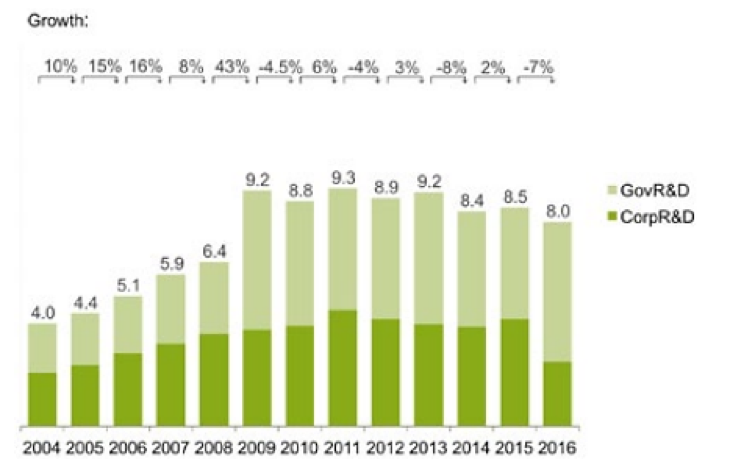
Figure KC.1 Global R&D Investment in Renewable Energy, 2004-2016, $BN
Source: Figure 54 from Global Trends in Renewable Energy Investment 2017 (McCrone et al. 2017), original data from Bloomberg, Bloomberg New Energy Finance, IEA, IMAF, various government agencies
Table KC.1 Renewable energy investment in the US by sector and type, 2016, $BN
Source: Figure 15 from Global Trends in Renewable Energy Investment 2017 (McCrone et al. 2017), original data from UN Environmental , Bloomberg New Energy Finance

Note: SDC: Small Distributed Capacity. Total values include estimates for undisclosed deals; VC/PE: Venture capital and private equity.
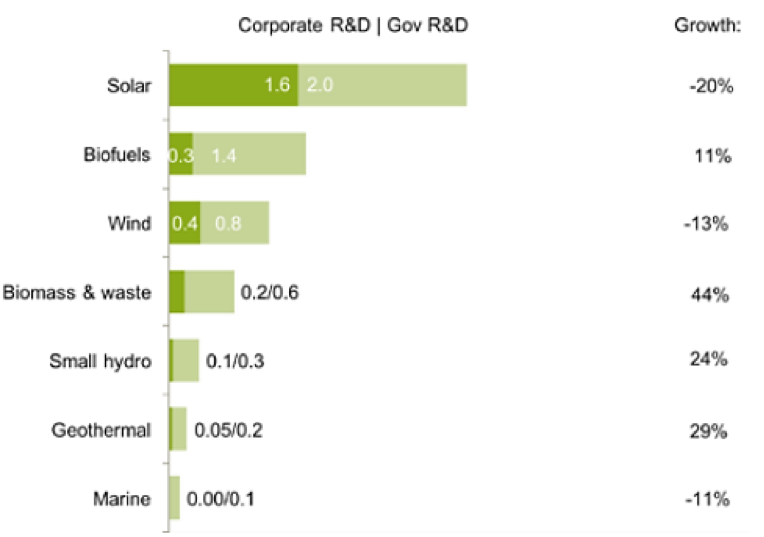
Figure KC.2 Renewable Energy R&D Global Investment by Technology Type
Source: Figure 55 from Global Trends in Renewable Energy Investment 2017 (McCrone et al. 2017), original data from Bloomberg, Bloomberg New Energy Finance, IEA, IMAF, various government agencies
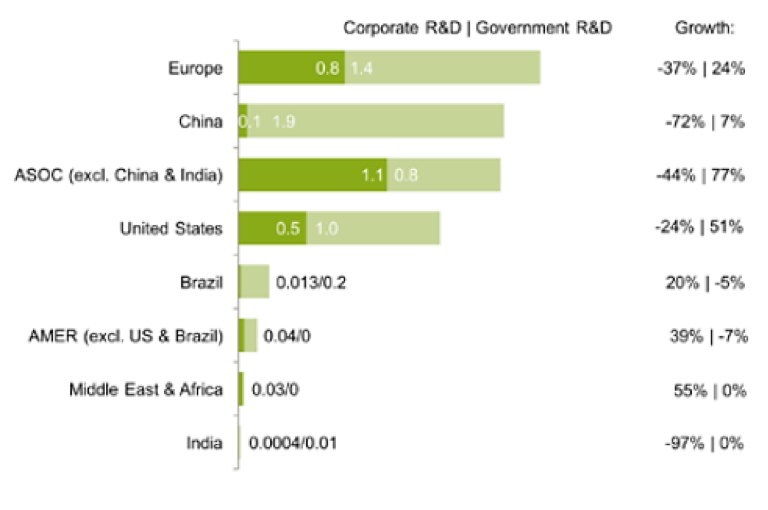
Figure KC.3 Renewable Energy R&D Global Investment by Region
Source: Figure 56 from Global Trends in Renewable Energy Investment 2017 (McCrone et al. 2017), original data from Bloomberg, Bloomberg New Energy Finance, IEA, IMAF, various government agencies
Knowledge Creation
Patent Quantity
Using the number of patents generated as a proxy for knowledge creation is an imperfect yet useful way to measure innovation. Patent counts are a particularly helpful metric of pre-commercial innovation output. Other similar indicators include publications, licenses, and tacit knowledge “know-how”. The PV industry is highly globalized, and accordingly, PV knowledge creation and spillover are also geographically dispersed. Because not all inventions are patentable and because patenting is not always perceived by firms as the most efficient and effective protection tool, the propensity to patent differs across firms, industries and the type of innovation. Firms must first exhibit innovation capabilities necessary to producing patentable knowledge and then have willingness to patent.
Knowledge relevant to PV technology is generated from diverse disciplines. Most energy innovations are not developed specifically by energy companies; instead, they enter the sector embodied in specialized equipment or innovative fuels from other sectors. For example, solar panels rely heavily on developments in semiconductors. Using a classification scheme mainly based on International Patent Classification (IPC) classes, Dominguez Lacasa and Shubbak (2018) categorize PV patents into six fields: (i) solar cells, (ii) solar panels, (iii) electronics, (iv) monitoring and testing, (v) energy storage, and (vi) portable devices for lighting, heating and cooling purposes. Additionally, PV patents can be categorized by value chain segment; For instance, provided a set of IPC codes based on value chain segments defined as follows: Upstream – silicon casting, turnkey manufacturing lines; Core – cell, module, manufacturing; Downstream – balance of system, after-sales services, energy storage (Figure KC.4). Note that these IPC categories only apply to first generation PV technology (i.e., crystalline silicon modules). IPC categories by PV technology generation can be found in Table KC.2. Information on PV patents can be found in numerous patent search databases including the United States Patent and Trademark Office (USPTO), the European Patent Office (EPO), Derwent World Patents Index, World Intellectual Property Organization, and Google Patents, etc.
Table KC.2 Descriptions of IPCs relevant to PV technology
Source: World Intellectual Property Organization and Appendix B from (Wu & Mathews, 2012)
| Technology generation | IPC | Description |
| 1stgeneration | E04D13 | Roof covering aspects of energy collecting devices |
| H01L21 | Processes or apparatus adapted for the manufacturer or treatment of semiconductor or solid state devices or parts thereof | |
| H01L31 | Semiconductor devices sensitive to infra-red radiation, light, electromagnetic radiation of shorter wavelength or corpuscular radiation and adapted either for the conversion of the energy of such radiation into electrical energy or for the control of electrical energy by such radiation | |
| H02N6 | Generators in which light radiation is directly converted into electrical energy | |
| C30B15 | Single-crystal growth by pulling from a melt, e.g. Czochralski method | |
| C30B28 | Production of homogeneous polycrystalline material with defined structure | |
| C30B29 | Single crystals or homogeneous polycrystalline characterized by the material or by their shape | |
| 2ndgeneration | C23C14 | Coating by vacuum evaporation, by sputtering or by ion implantation of the coating forming material |
| C23C16 | Chemical coating by decomposition of gaseous compounds, without leaving reaction products of surface material in the coating, i.e. chemical vapor deposition (CVD) processes | |
| 3rdgeneration | H01G9/028 | Organic semiconducting electrolytes |
| H01L51 | Solid state devices using organic materials as the active part, or using a combination of organic materials with other materials as the active part |
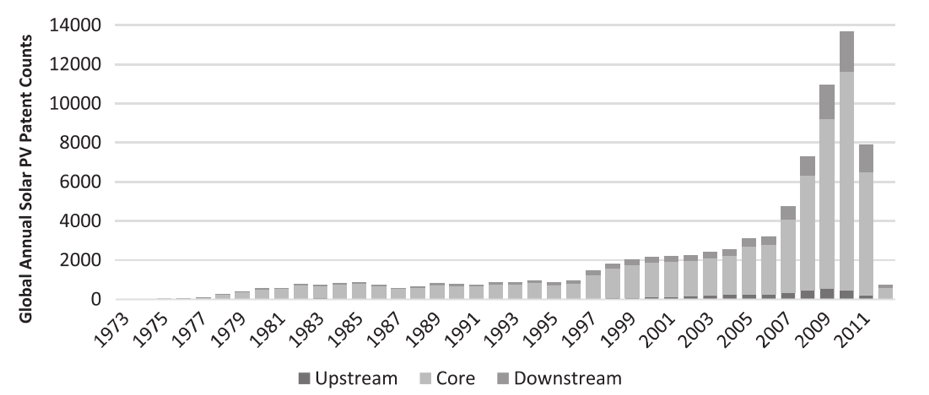
Figure KC.4 Global annual 1st generation solar PV patent counts
Source: Top panel of Figure 6 from (Binz et al., 2017)
Note: Upstream: silicon, silicon doping, ingots, and wafer sawing; Core: cell, module manufacturing; Downstream: inverters, batteries, grid integration, rooftop covers, consumer products. Source: (Binz et al., 2017)
Figures KC.5 and KC.6 illustrate the current knowledge landscape of PV technology, as compiled from many sources of patents. Figure KC.5 represents solar PV patent evolution in the US, while Figure KC.6 presents a global overview of recent PV patents by country. Note that these results represent a general summary and trend in knowledge stock, and do not reflect the nuance of the search terms, data sources, and scope defined by each of the individual studies.
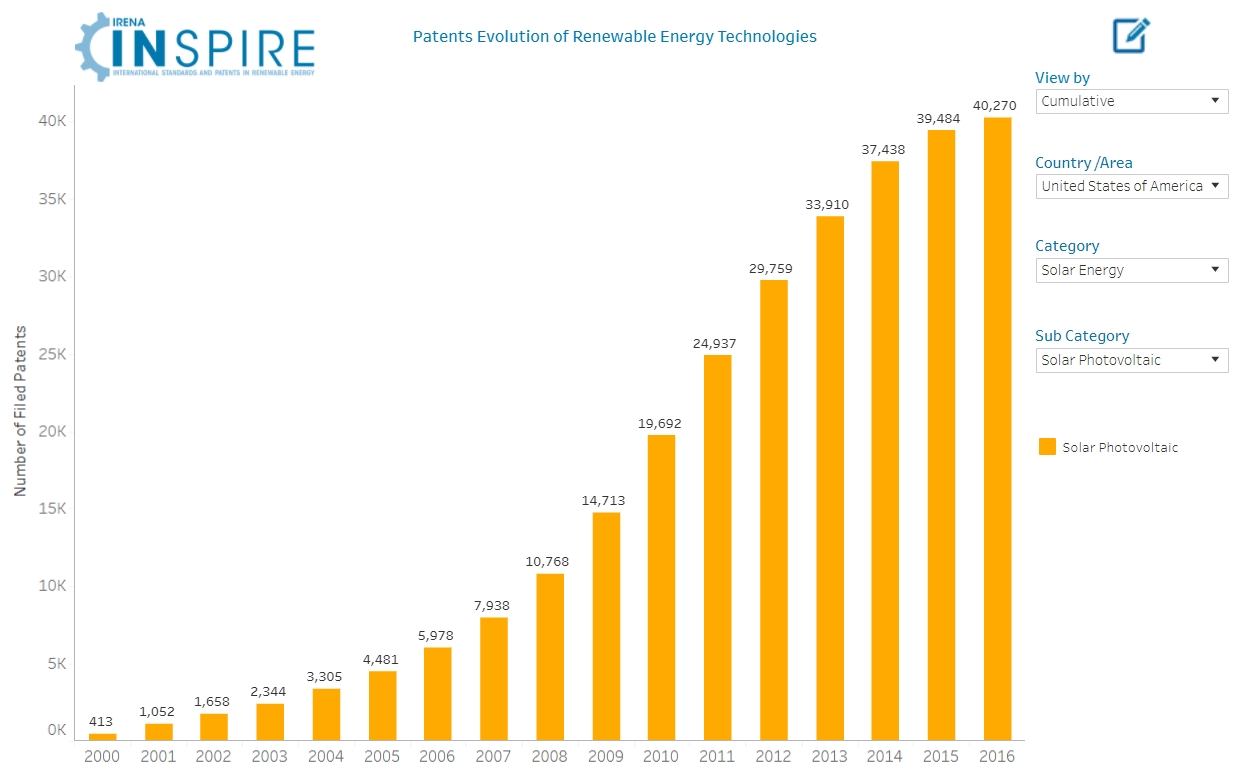
Figure KC.5 Accumulated Patent Evolution of PV Technology in the US
Source:(IRENA, 2017)
Note: The information in this search utilizes data from EPO PATSTAT and uses the Climate Change Mitigation Technologies (Y02) classification by EPO.
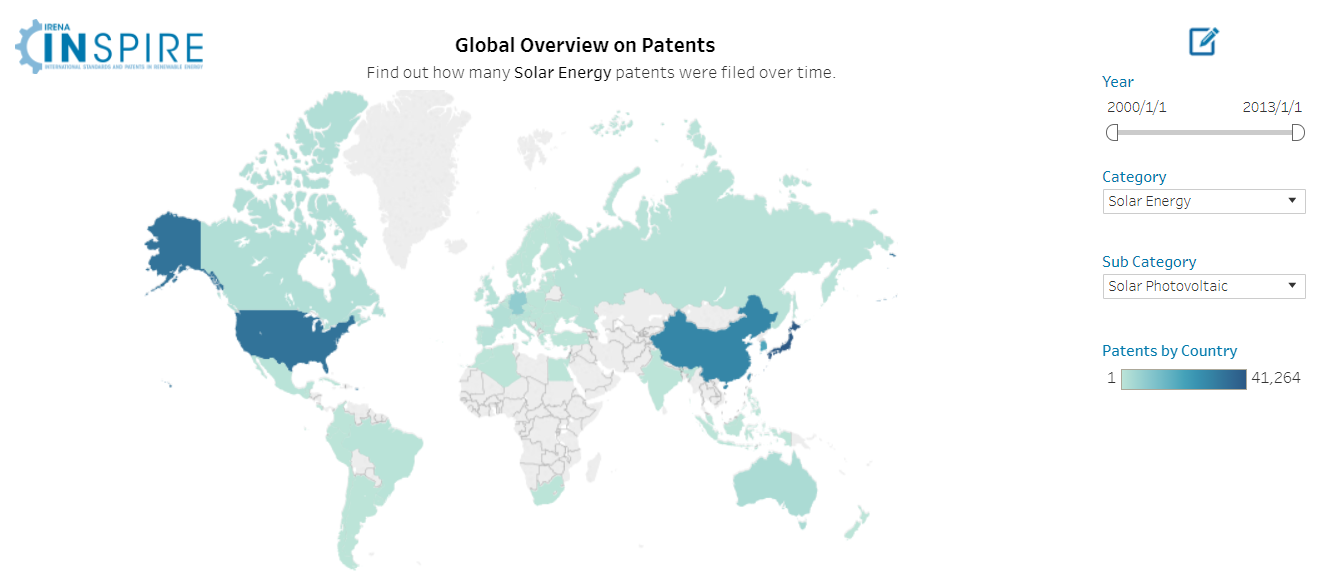
Figure KC.6 Global Overview on PV Patents (accumulated patent counts between 2000 and 2013)
Source:(IRENA, 2017)
Note: The information in this search utilizes data from EPO PATSTAT and uses the Climate Change Mitigation Technologies (Y02) classification by EPO.
Historically, PV technology knowledge was created by pioneer innovators in the US and Japan (e.g., companies included in Figure KC.7). Today, US patents represent a lower share of the global PV patents compared to 20-30 years ago, but retain higher quality measures throughout the lifecycle in all PV value chain segments. Previous studies demonstrated that, historically, PV knowledge creation and technology innovation dynamics remained largely unaffected by globalization of the PV market and relocation of primary manufacturing sites (see Figure KC.8). This implies that creating basic R&D driven inventions and pioneering companies in an emerging industry is by no means a guarantee that significant manufacturing volumes and jobs will be retained in the same country in later industry lifecycle phases.
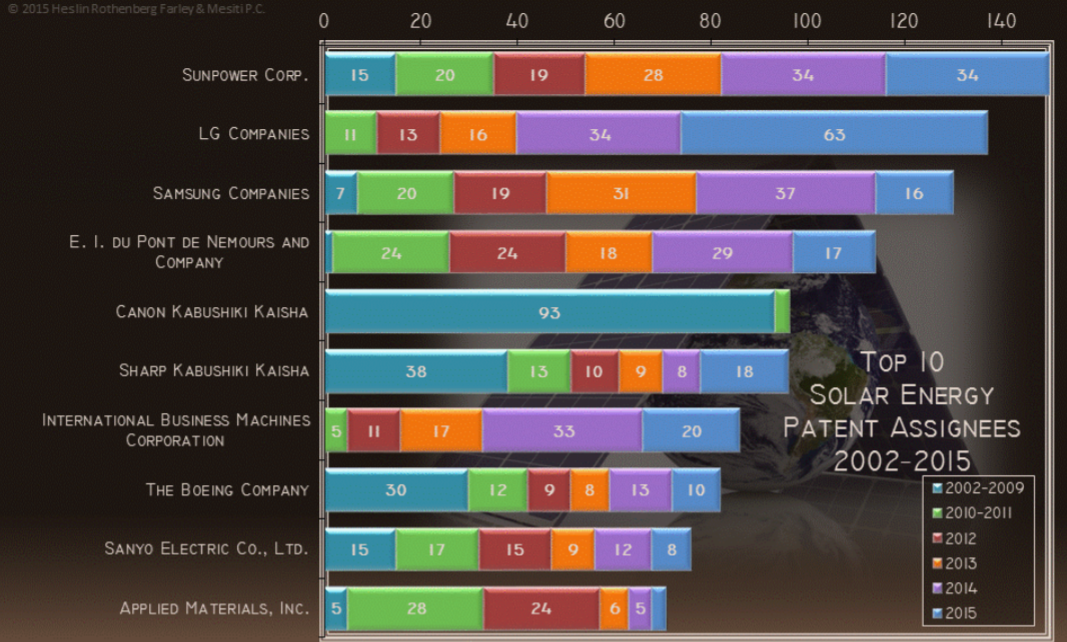
Figure KC.7 Top Solar Energy Patent Assignees 2002-2015
Source: Clean Energy Paten Growth Index (CEPGI) 2015 Year in Review
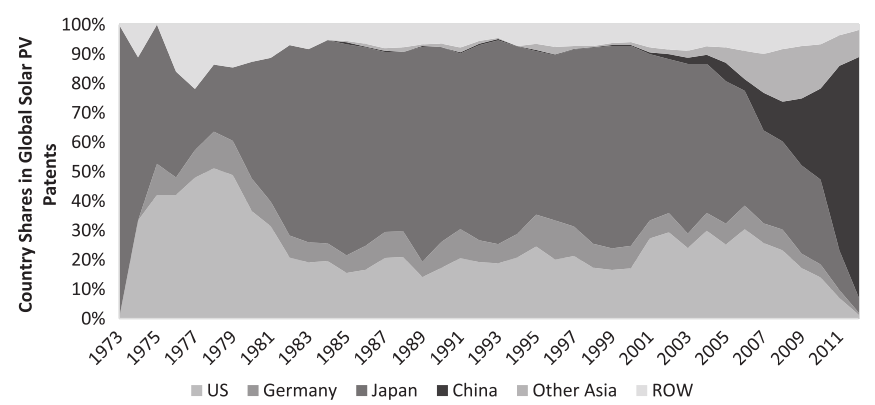
Figure KC.8 Country shares in global 1stgeneration solar PV patents
Source: Second panel of Figure 6 from Source: (Binz et al., 2017)
Bibliometric Analysis
Bibliometric analysis applies quantitative and statistical methods to study trends in the quantity and quality of published materials (e.g., journal articles); it includes authorship, citation, and journal analysis, as well as analysis of publication impact. Bibliometric analysis can be used to track trends in publication regarding renewable energy, including tendency to discuss specific topics and technologies, as well as any changes in the primary geographic sources of publication. Dong et al (2012) performed a bibliometric analysis on solar power-related research published between 1991-2010. The results showed that the US has the greatest counts of single-country PV-related publications, and it was also a frequent partner in international collaboration, contributing to 13.5% of all the international collaborative articles during the analysis period. However, the influence of other countries is increasing, with Mainland China and South Korea, in particular, showing the highest growth pace since 2006 (Figure KC.9). Dong et al (2012) indicated that publications on solar power research have predominantly focused on fundamentals such as chemistry and materials. Regarding article keywords, “solar cell” was by far the dominant topic, in line with its importance in global patenting.
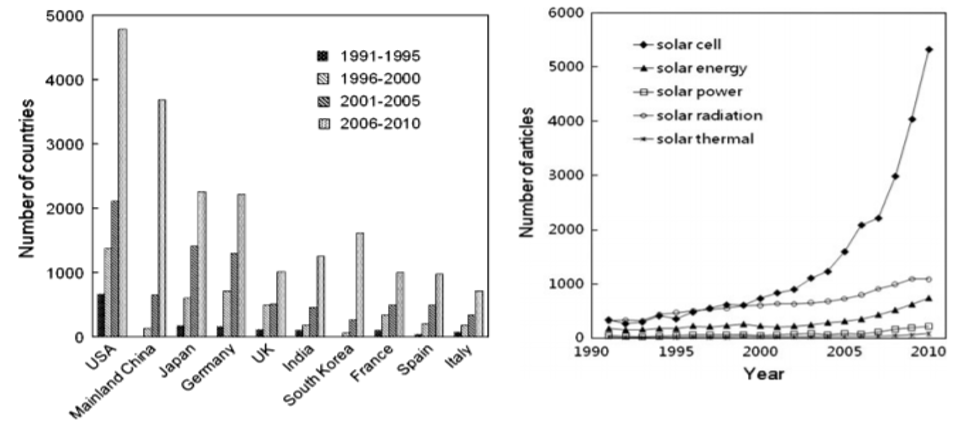
Figure KC.9 Numbers and trend of solar power technology related publications by country (left chart) and by keyword (right chart), 1991-2010
Source: Figure 3 and Figure 4 from (Dong et al., 2012)
Knowledge Spillover
Knowledge spillover is hard to measure because it tends to be less tangible or readily observable than other innovation metrics. Spillover can be considered between companies, between public and private institutions, and across geographies. Firms often aim to appropriate the returns of innovation (i.e., prevent knowledge spillover) through patents or secrecy. Backward and forward citation of patents can reveal connections between the knowledge imbedded in technologies; backward citation refers to patents cited in the patent of interest, while forward citation refers to patents citing the patent of interest. Patent citation and patent family size are commonly used to measure patent quality. Patent family size refers to the number of patents taken by multiple countries to protect the same invention. Kim et al confirmed that a renewable energy firm’s patent protection ability is important for its financial performance. They also found that the backward citation of patents and the size of patent families, more so than simple patent counts, are important measures of the ability of firms in this industry to protect the knowledge they develop. As Figure KC.10 shows, US PV patents have retained the highest quality (i.e., number of forward citations), particularly for core and downstream technologies, even though the US share of total PV patents has been declining since 2005.
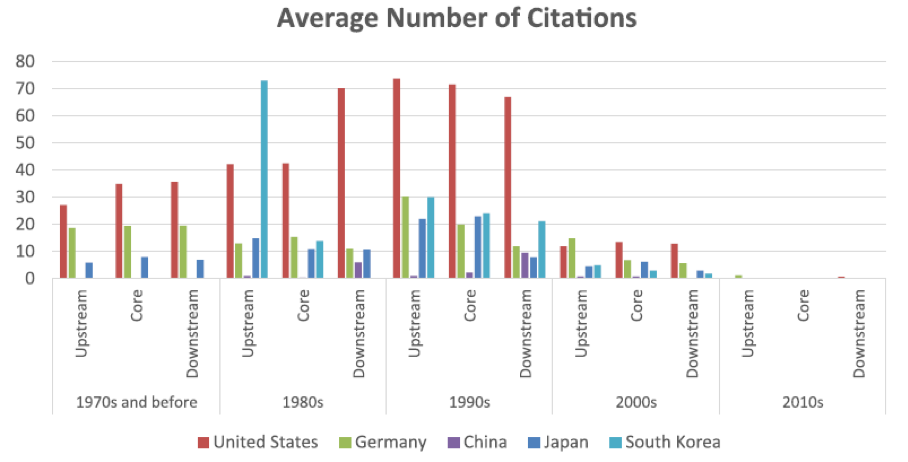
Figure KC.10 Average forward (citing) citations of patents filed in major solar PV (1stgeneration) countries
Source: Panel (A) of Figure B.1 from(Binz et al., 2017)
Research Collaboration
Knowledge can also spread as teams collaborate on research and publication. Network analysis, the characterization and investigation of social structures through graphs of nodes (e.g., people, things) and linkages (e.g., relationships, interactions), can be used to explore the connections between different groups of researchers involved in the same field of study. Regarding research collaboration, conducted a bibliometric and social network analysis for publications on solar technologies (including PV, CSP, and solar thermal). They identified five cooperation networks within the field (see Figure KC.11). The analysis showed that the US (cluster B, and to a lesser extent, cluster E) is notable for its numerous national and international partnerships; US organizations (cluster B) serve as a hub for the whole network, mediating relationships between different clusters. These organizations include NASA, Washington University, the National Institute for Environmental Studies, CALTECH and many others. Among other network participants, China (cluster A) engages in a high degree of local and national cooperation; European countries (cluster C and D) are notable for international partnerships.
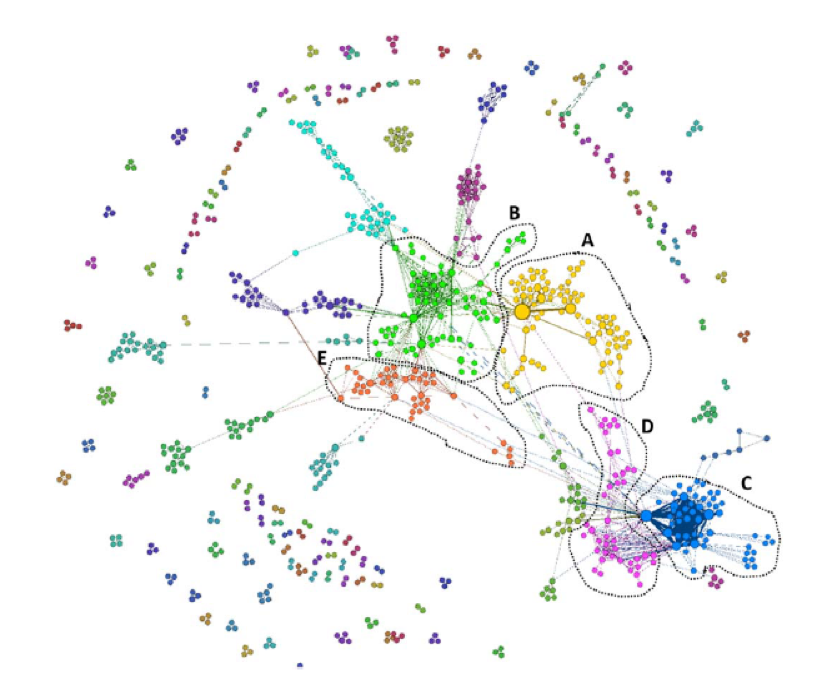
Figure KC.11 Solar co-authorship network of organizations
Source: Figure 9 from (de Paulo & Porto, 2017)
Note: A: Predominantly Chinese organizaitons and others from Asian and US; B: Mostly from USA, a hub for the whole network; C: European organizations from Denmark, Germany, Belgium, France and the Netherlands; D: European organization and others including Spain, Finland, England, Switzerland, India and Turkey; E: mostly US domestic organizations.
Tacit Knowledge Transfer
Tacit knowledge is a primary source of research spillovers because this type of knowledge is embodied in the skills of the firm’s employees. Tacit knowledge includes rules of thumb, heuristics, and tricks of the trade, as compared to the knowledge embodied in a technology; it may be related to products or processes. Informal exchanges between researchers and job turnover between firms are channels through which tacit knowledge flows from one firm to the other. Indicators such as number of R&D personnel and innovation expenditure could be considered a proxy for tacit knowledge transfer, although the validity of this proxy will depend on the type of tacit knowledge to be transferred. Generally, intrafirm transfer modes involving a high level of direct human interaction (e.g., joint ventures, international research centers) are more effective than so-called arms-length transfer mechanisms (e.g., personnel relocating) In the case of PV technologies, tacit knowledge could be exchanged through human resource transfer, training, joint R&D programs, process licensing, trade in production equipment, and trade in turnkey production facilities. Figure KC.12 provides an example of international tacit knowledge transfer for solar PV technology.
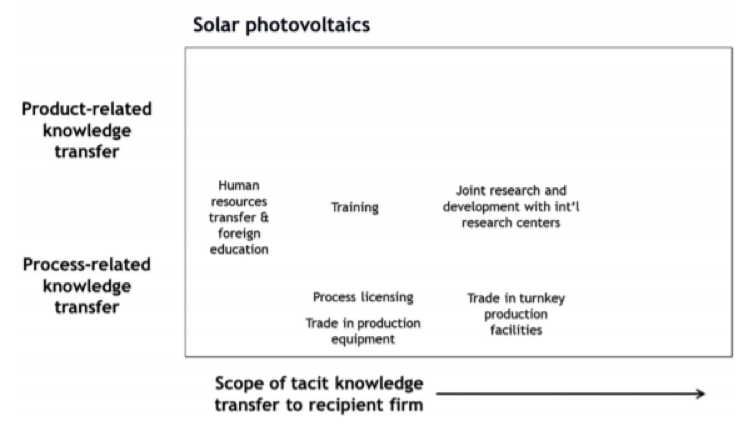
Figure KC.12 An Example of International Tacit Knowledge Transfer for Solar PV Technology
Source: Figure 1 from (Quitzow et al., 2017)
Overview of Geography
Previous studies (e.g., Binz et al., 2017) demonstrated that, historically, PV knowledge creation and technology innovation dynamics remained largely unaffected by globalization of the PV market and relocation of primary manufacturing sites. There are few factors contributing to this geographic decoupling of PV knowledge creation from global PV manufacturing locales as well as demand market locations.
First, manufacturing of clean energy components and equipment that have low transportation costs can easily occur geographically separated from innovation hubs, in areas of the U.S. or of the world that focus on modern manufacturing capabilities. In cases where technologies are costly to transport, manufacturing generally occurs in physical proximity to upstream suppliers and the final market.
Second, geographical separation of innovation from manufacturing is possible when product design, manufacturing process technology, and end consumers do not require close integration; this is often the case in later stages of commercialization. The typical configuration of manufacturing plants among the largest cell and module manufacturers is to produce cells in their home country, usually at or near headquarters, where R&D facilities tend to be located. As a nascent technology, crystalline silicon PV gained innovation benefits from the proximity of R&D and production. However, as technologies mature and become commercialized, key characteristics of the product are generally not influenced by the manufacturing process; hence, R&D and manufacturing can operate independently of each other and the separation of innovation from manufacturing generally do not harm innovation. categorized mature solar photovoltaics (i.e. crystalline silicon PV) as a “footloose” global innovation system, meaning that there is strong spatial knowledge spillover in investor-driven mass market networks with many international trades.
On the other hand, innovation in technologies in the early stages of development and commercialization, such as thin film and other emerging PV products, can benefit from co-location of R&D and manufacturing facilities. Co-location of innovation centers with manufacturing activities is more important when product design and manufacturing process technology require close integration, often in early stages of development and commercialization. This explains the high concentration of thin film plants in California (Silicon Valley) and Colorado (NREL), and is part of the reason why the concentration of thin film of production in the U.S. greatly exceeds its share globally.